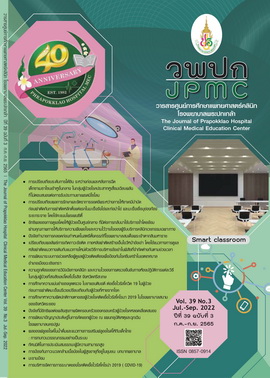Developing Artificial Intelligence for Triage at the Emergency Department, Nakhon Pathom Hospital
Main Article Content
Abstract
BACKGROUND: Triage can help the prioritization of treatment for patient safety. The utilization of artificial intelligence (AI) could assist nurses to perform triage more accurately and quickly.
OBJECTIVES: The purposes of this study were 1) to develop the Nakhon Pathom Triage Application (NPTA), and 2) to assess the accuracy and time spent for triage using NPTA.
METHODS: This action research examined subjects comprising 10 registered nurses working at the Emergency Department, Nakhon Pathom Hospital. The research tools included 1) the NPTA developed by the research team using the Artificial Intelligence (AI) in Clinical Care framework, and the national emergency patient screening criteria called ‘MOPH ED Triage’. The content validity index of NPTA was 1.0, and the Receiver Operating Characteristic (ROC) analysis showed that the area under curve (AUC) value was .84. The second research tool was 2) the outcome record of triage accuracy and time utilization. The Index of Item-Objective Congruence (IOC) of this record was 1.0, and its reliability when testing the NPTA for triage yielded inter-rater reliability of 1.0. Data were analyzed by using descriptive statistics.
RESULTS: The results showed that 1) the NPTA was an AI using data management technology for the assessment of life-threatening condition, vital signs, pain scale, chief complaint and number of health resource utilization so as to identify triage level, and 2) the accuracy rate for triage level using the NPTA was 100 percent, demonstrating in all 30 case scenarios of different triage levels including level 1, 2, 3, 4 and 5. Average time utilization for the triage process for levels 1, 2, and 3 was 4.0±1.1, 18.6±4.5 and 25.3±6.8 seconds, respectively.
CONCLUSIONS: NPTA is a technology that allows for accurate and rapid triage.
Article Details

This work is licensed under a Creative Commons Attribution-NonCommercial-NoDerivatives 4.0 International License.
References
Zachariasse JM, vad der Hagen V, Seiger N, Mackway-Jones K, van Veen M, Moll HA. Performance of triage systems in emergency care: a systematic review and meta-analysis. BMJ open [Internet]. 2019[cited 2021 Apr 20];9:1-9. Available from: https://www.ncbi.nlm.nih.gov/pmc/articles/PMC6549628/pdf/bmjopen-2018-026471.pdf
Sukswang S. Triage nurse: beyond main process through practice. JOHSS [Internet]. 2018 [cited 2021 Mar 1];5:1-14. Available from: https://he01.tci-thaijo.org/index.php/johss/article/view/156934/115944
Techathik P, Sumritrin S, Sirithongsuk A, Phungern P. Delaying time period of the service for accident and emergency patients. Thai Journal of Nursing and Midwifery Practice 2017;4:25-35.
Silapavitayatorn B, Chitpakdee B. The use of health information technology in nursing for patient safety. Journal of Nursing and Health Care 2020;38:6-14.
Girosi F, MannS, KareddyV. Narrative review and evidence mapping: artificial intelligence in clinical care.[Internet]Washington: RAND Corporation; 2021 [cited 2021 Mar 1].Available from: https://www.rand.org/content/dam/rand/pubs/external_publications/EP60000/EP68705/RAND_EP68705.pdf
Sutham K, Khuwuthyakorn P, Thinnukool O. Thailand medical mobile application for patients triage base on criteria based dispatch protocol. BMC Med Inform Decis Mak [Internet]. 2020 [cited 2021 Apr 20];20:1-13. Available from: https://www.ncbi.nlm.nih.gov/pmc/articles/PMC7147000/
Abedi V,Khan A, ChaudharyD, Misra D, Avula V, Mathrawala D, et al. Using artificial intelligence for improving stroke diagnosis in emergency departments: a practical framework. Ther Adv Neurol Disord [Internet].2020 [cited 2021 Apr 20];2020;13:1-8 Available from:https://journals.sagepub.com/doi/pdf/10.1177/1756286420938962
Ministry of Public Health. MOPH ED.Triage [Internet]. Nonthaburi: Department of Medical Services, Ministry of Public Health; 2018 [cited 2020Mar 15]. Available from:http://www.nktcph.go.th/attachments/article/Ttiage_MOPHEDTRIAGE.pdf
Thesprasit T. Development of a system for classification of patients in outpatient and emergency departments at Chokchai Hospital. Regional Health Promotion Center 9 Journal 2021; 15:160-78.
Saetae N, Nanui P. Development of a new MOPH ED Triage model for emergency departments of Yala hospital network. The Southern College Network Journal of Nursing and Public Health 2021; 9(1) :149-61.
Sarakarn P, Munpolsri P. Optimal cut-off points for receiver operating characteristic (ROC) curve analysis in developing tools of health innovations: example using STATA. Thai Bulletin of Pharmaceutical Sciences 2021:16;93-108.
Donabedian A. An introduction to quality assurance in health care. New York: Oxford University Press; 2003.
Imwatanakul N. Effectiveness of triage mobile application campares with paper based. Royal Thai Air Force Medical Gazette [Internet]. 2019 [cited 2021 Mar 1];65:1-9. Available from: https://he02.tci-thaijo.org/index.php/rtafmg/article/download/216093/150157/689876
JonesLL,Toulson KL.Principles of emergency and trauma nursing. In Ignatavicius DD, Workman ML, Rebar CR, LaCharity LA, KumagaiCK, editors. Study guide for medical-surgical nursing : concepts for interprofessional collaborative care. 2nded. St. Louis: Elsevier; 2018. p.117-32.
Yu JH, Park S, Kwon SH, Ho CMB, Pyo CS, Lee HS. AI- based stroke disease prediction system using real time electromyography signals. Appl. Sci [Internet]. 2020 [cited 2021 May 7];10(19): 6791. Available from: https://doi.org/10.3390/app10196791
Lee TY, Sun GT, Kou LT, Yeh ML. The use of information technology to enhance patient safety and nursing efficiency. Technol Health Care2017;25:917-28.

